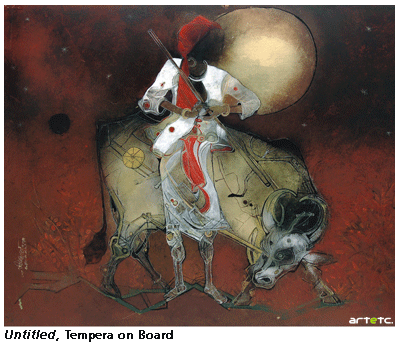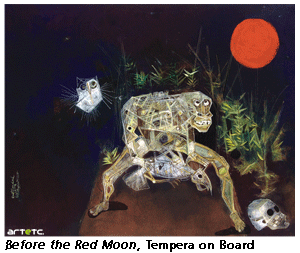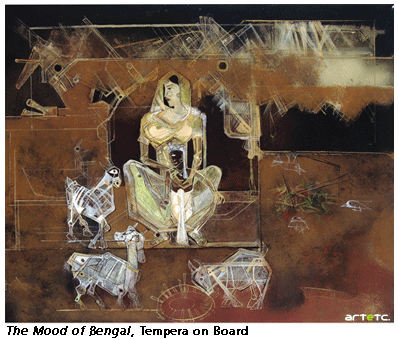- Publisher's Note
- Editorial
- Looking from the Other Side
- Women in Rabindranath Tagore's Paintings
- Ramkinkar Baij's Santhal Family
- The Birth of Freedom in Moments of Confinement
- Jamini Roy's Art in Retrospect
- The Great Journey of Shapes: Collages of Nandalal Bose
- Haripura Posters by Nandalal Bose: The Context and the Content
- The Post-1960s Scenario in the Art of Bengal
- Art Practice in and Around Kolkata
- Social Concern and Protest
- The Dangers of Deifications
- Gobardhan Ash: The Committed Artist of 1940-s
- Gopal Ghose
- Painting of Dharmanarayan Dasgupta: Social Critique through Fantasy and Satire
- Asit Mondal: Eloquence of Lines
- The Experiential and Aesthetic Works of Samindranath Majumdar
- Luke Jerram: Investigating the Acoustics of Architecture
- Miho Museum: A Structure Embedded in the Landscape
- Antique Victorian Silver
- Up to 78 Million American Dollars1 !
- Random Strokes
- Are We Looking At the Rise of Bengal
- Art Basel and the Questions it Threw Up
- What Happened and What's Forthcoming
- Art Events Kolkata, May – June 2012
- Mumbai Art Sighting
- Delhi Dias
- Art Bengaluru
- Preview June, 2012 – July, 2012
- In the News, June 2012
ART news & views
Asit Mondal: Eloquence of Lines
Issue No: 30 Month: 7 Year: 2012
by Natasha Sikdar
 Satyajit Ray considered Asit Mondal's works to have the 'most attractive and original decorative style' and 'a pleasing sense of colour and design' at the beginning of the latter's artistic career in 1979. Since then Mondal traveled a long way but the two existing features that Ray noted in his early works still remains despite lots of alterations and developments in his executions during the long period. Decorativeness is often considered a belittling term in the context of so-called exalted art or thought provoking art. It was the reason due to which some of the European scholars undermined Oriental or Indian Art during 19th and early 20th century. Fine Art and Decorative Art were considered as two separate genres of human visual expressions, former possessing aesthetically a higher status than the later. It was never possible for them to conceive that decorativeness has its own philosophy. Primitive, tribal and folk art of our country and also those around the world provide ample examples of this.
Satyajit Ray considered Asit Mondal's works to have the 'most attractive and original decorative style' and 'a pleasing sense of colour and design' at the beginning of the latter's artistic career in 1979. Since then Mondal traveled a long way but the two existing features that Ray noted in his early works still remains despite lots of alterations and developments in his executions during the long period. Decorativeness is often considered a belittling term in the context of so-called exalted art or thought provoking art. It was the reason due to which some of the European scholars undermined Oriental or Indian Art during 19th and early 20th century. Fine Art and Decorative Art were considered as two separate genres of human visual expressions, former possessing aesthetically a higher status than the later. It was never possible for them to conceive that decorativeness has its own philosophy. Primitive, tribal and folk art of our country and also those around the world provide ample examples of this.
 This decorative style which Mondal adopted as one of his formal attributes was probably accepted deliberately by him as a way to connect himself with the living traditions of our country. This rootedness is a prime feature of his works. After completing his course in painting from Indian College of Arts and Draftsmanship, Calcutta in 1970, where he was adequately trained in Western modern techniques under such celebrated artists, who were his teachers there, like Bikash Bhattacharya, Suhas Roy and Bipin Goswamy, he chose to adopt the traditional indigenous forms and techniques that are being practiced in our classical, folk and tribal arts. From 1970 onwards he participated widely in exhibitions organized by Lalit Kala Akademi of Delhi, West Bengal and Orissa. During 1970-74 he participated in group shows like WBYAF, AUC. He also participated in group shows at Aakriti Art Gallery, Kolkata. He also had various solo exhibitions in 1973 and 1977 at Academy of Fine Arts, Kolkata, Alliance Francaise, Kolkata in 1980, in 1988 at the Genesis Art Gallery Kolkata and at Aakriti Art Gallery in 2008. He received a number of prestigious awards like the Academy Awards of 1974-75 and the West Bengal State Academy Award of 1979-81.
This decorative style which Mondal adopted as one of his formal attributes was probably accepted deliberately by him as a way to connect himself with the living traditions of our country. This rootedness is a prime feature of his works. After completing his course in painting from Indian College of Arts and Draftsmanship, Calcutta in 1970, where he was adequately trained in Western modern techniques under such celebrated artists, who were his teachers there, like Bikash Bhattacharya, Suhas Roy and Bipin Goswamy, he chose to adopt the traditional indigenous forms and techniques that are being practiced in our classical, folk and tribal arts. From 1970 onwards he participated widely in exhibitions organized by Lalit Kala Akademi of Delhi, West Bengal and Orissa. During 1970-74 he participated in group shows like WBYAF, AUC. He also participated in group shows at Aakriti Art Gallery, Kolkata. He also had various solo exhibitions in 1973 and 1977 at Academy of Fine Arts, Kolkata, Alliance Francaise, Kolkata in 1980, in 1988 at the Genesis Art Gallery Kolkata and at Aakriti Art Gallery in 2008. He received a number of prestigious awards like the Academy Awards of 1974-75 and the West Bengal State Academy Award of 1979-81.

But, during his institutional training and practices thereafter, he made a strong base in modern European and naturalistic style, for which he was very much indebted to his teachers, who were/are stalwarts in the field of modern Indian painting and sculpture. For Mondal this base was very true. So when he started his sojourn towards the root, he did it standing on this strong modernist base which helped him to come out of the usual weaknesses and idiosyncrasies that are frequently noticed in some of the shallow renderings of the so called Indian style of painting.
He adopted tempera as a major medium, where he could experiment with the luminosity of colour that the jubilant sunny atmosphere of our land calls for and also adopt the environment of enlightened dreams that the myths ingrained in our communal flowing life provide. He thus tries to extract the transcendental enchantments from the collective unconscious of the present complex existence. This may be termed as an outline of the theme of his works. To provide a dimension of the contemporary existential complexities he resorts to the modernistic linear arrangements, which he has internalized through his academic training and long personal practices.
 His works are mostly linear reflecting his personal world. He uses a fusion of smart straight lines meeting in sharp angles giving rise to a decorative flavour, also exuding some kind of cubistic arrangement. This duality, lyrical decorativeness and cubistic complexities, these apparently opposing qualities, are the crux of his construction. His works are in the same fold constructivist. The luminous colour composition in building up the background environment or landscape elements, sometimes providing an added exuberance through use of golden layer, brings out a pulsating lyrical tinge. Here he can impose a kind of meditative contemplativeness that can be sensed in the world of our miniatures or some of the best products of neo-Indian school. He builds up the figurative elements in linear constructions, against this lyrical setting. In these constructions, he tries to assimilate various local and global traditions. Constructional complexities growing out of linear network often strike of a cubistic movement, but that structural characteristic may not essentially be a European modernistic product, there one can have a feeling of primitivistic or tribal expressionistic elements also. This creative circuit is an essential feature of modernity. The expressionistic elements in his paintings yield to various kinds of fantasy elements, where in the submerged layers one can feel the archetypal flavour of Paul Klee. Very often an Egyptian silence reigns.
His works are mostly linear reflecting his personal world. He uses a fusion of smart straight lines meeting in sharp angles giving rise to a decorative flavour, also exuding some kind of cubistic arrangement. This duality, lyrical decorativeness and cubistic complexities, these apparently opposing qualities, are the crux of his construction. His works are in the same fold constructivist. The luminous colour composition in building up the background environment or landscape elements, sometimes providing an added exuberance through use of golden layer, brings out a pulsating lyrical tinge. Here he can impose a kind of meditative contemplativeness that can be sensed in the world of our miniatures or some of the best products of neo-Indian school. He builds up the figurative elements in linear constructions, against this lyrical setting. In these constructions, he tries to assimilate various local and global traditions. Constructional complexities growing out of linear network often strike of a cubistic movement, but that structural characteristic may not essentially be a European modernistic product, there one can have a feeling of primitivistic or tribal expressionistic elements also. This creative circuit is an essential feature of modernity. The expressionistic elements in his paintings yield to various kinds of fantasy elements, where in the submerged layers one can feel the archetypal flavour of Paul Klee. Very often an Egyptian silence reigns.
Through assimilation of all these opposite elements he tried to build up an indigenous yet original identity of his paintings, but at the same time his endeavours to break a fixed pattern of execution that can be termed as a 'signature' of the artist. He always wanted to eliminate that closed boundary, which in the name of identity limits the expression of the artist. He works in various forms. While his linear constructional executions suggest the presence of pulsating decorativeness, his 'board-brush' freehanded board-stroked works indicate a release of human emotions. He dwells both in the intuitive twilight zone of the mythical past and connects it to the present, where the forms of man and animal or bird amalgamate, also within the heat of the angst and terror generated by 'power' that stands as an obstacle to human progress. Within this diversity of expression, his commitment stands fixed towards a divine beauty that our rooted existence radiates, where various global currents are continuously merging. His decorativeness always vibrates with the euphoric life around him.